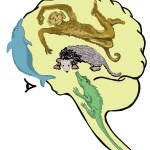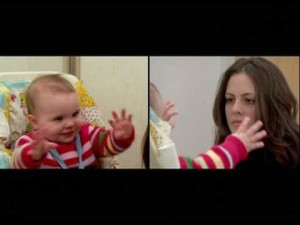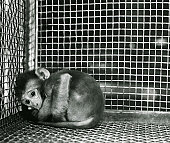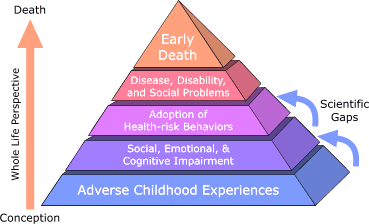 My Feb. 7 post “Love Theory” introduced “General Theory of Love” (GTL), the best book I’ve seen on the three-part or “triune” brain and human emotions. Basic survival instincts are in the reptilian brain, mammalian emotions are in the limbic brain, thought is in the frontal lobe. [FN1]
My Feb. 7 post “Love Theory” introduced “General Theory of Love” (GTL), the best book I’ve seen on the three-part or “triune” brain and human emotions. Basic survival instincts are in the reptilian brain, mammalian emotions are in the limbic brain, thought is in the frontal lobe. [FN1]
After adding that the brain’s distinct parts create a “stove-pipe” problem because they don’t communicate well with one another, GTL proceeds to Attachment Theory. The very development of an infant’s brain after birth, they say, depends utterly on the mother’s close affectionate attention, using a deep eye contact they dub “limbic resonance.” If the baby doesn’t get deep eye contact and attunement? Brain damage.
Not Mom. Not Again. I’m sick of being upset about Mom. Couldn’t I be upset at someone else, say Dick Cheney? OK laugh, but he’s relevant. How did Mrs. Cheney’s bouncing baby grow up to become Darth Vadar, anyway? Let’s look at the biological facts.
“Mothers use the universal signals of emotions to teach their babies about the world,” begins GTL. “Babies continuously monitor their mothers’ expressions. If a mother freezes her face, her baby becomes upset and begins to cry in short order…
“Why should a creature with relatively few skills be so monomaniacally focused on tiny muscular contractions beneath the skin of another creature’s body? Emotionality enables a mammal to sense the inner states and the motives of the mammals around him…
“A baby is born with almost no limbic programming. It needs continual feedback from the mother’s face to learn how to run basic physical functions… Mammals developed a capacity we call ‘limbic resonance’… whereby two mammals become attuned to each other’s inner states” by deep eye contact.
“Secure attachment resulted when a child was hugged when he wanted to be hugged, and put down when he wanted to be put down. When he was hungry, his mother knew it and fed him…. By what grace? Limbic resonance gives her the means to that telepathy…”
The “Still Face” Experiment
 “By looking into his eyes and becoming attuned to his inner state, a mother can reliably intuit her baby’s feelings and needs,” says GTL. “The regular application of that knowledge changes a child’s emotional makeup… Attachment penetrates to the neural core of what it means to be a human being.”
“By looking into his eyes and becoming attuned to his inner state, a mother can reliably intuit her baby’s feelings and needs,” says GTL. “The regular application of that knowledge changes a child’s emotional makeup… Attachment penetrates to the neural core of what it means to be a human being.”
These concepts are demonstrated graphically by a one-year old baby in the “Still Face” experiment. Dr. Ed Tronick of the U Mass Boston’s Infant-Parent Mental Health Program did his first “Still Face” work in 1975; his 2007 video has over 1.3 million hits. First a mother and child play in an eye-to-eye and also responsive, attuned way, so the baby learns to interact with the world. Click here for video: www.youtube.com/watch?v=apzXGEbZht0&feature=youtu.be
Then the mother presents a still, emotionally barren face – her eyes give the baby no feedback. The baby in seconds goes into a tailspin, unable even to maintain body posture. When the mother resumes her normal empathic expressions, her baby is visibly relieved. “Prolonged lack of attention can move an infant from ‘good’ socialization, to periods of ‘bad’ but repairable socialization,” Dr. Tronick says. “In ‘ugly’ situations the child does not receive any chance to return to the good, and may be traumatized.”
“A mother continuously adjusts her infant’s physiology,” as GTL puts it. “When the mother is absent, an infant loses all his organizing channels at once. Like a marionette with its strings cut, his physiology collapses into the huddled heap of despair…
“The mammalian nervous system depends for its neurophysiological stability on a system of interactive coordination, wherein steadiness comes from synchronization with nearby attachment figures,” our three shrinks forge on. “A baby’s physiology is maximally open-looped; without limbic regulation from the mother or some human caretaker, his vital rhythms will collapse and he will die… Limbic regulation directs…the development of the brain itself.”
When I first read this in 2009, I felt a wave of fear. Fear? That makes no sense, why so much fear? Oh, well, I can’t imagine my mom looking into my eyes much, let alone to do something as silly as figure out my “feelings and needs.” I thought feelings were something stupid to get rid of. Needs? What does that even mean? Mom wasn’t into eye contact, and who cares? I sure didn’t; I had no idea people looked much at kids, except if we annoyed them.
Except, wait: now science sez this means my brain was maybe fried as an infant? That could cause some fear. As if reading my mind, the three shrinks proceed:
Isolating Mammals
“Take a puppy away from his mother… and you witness the universal mammalian reaction to the rupture of an attachment bond,” GTL writes. “A lone puppy first enters the protest phase. He paces tirelessly, scanning his surroundings, barking, scratching vainly at the floor… He lets out a piteous whine, high-pitched and grating. Every aspect of his behavior broadcasts distress…”
And it’s not all in his head. “A mammal in protest shows a distinct physiology. Heart rate and body temperature increase, as to levesl of catecholamines and cortisol… Cortisol is the body’s major stress hormone, and its sharp elevation tells us that the relationship rupture is a severe bodily strain.”
 But wait. “If the separation is prolonged, a mammal enters the second stage,” the doctors warn, and it’s called despair. “Despair begins with collapse into lethargy; the animals stops his back and forthing, stops whimpering, and curls up into a despondent lump. He drinks little and may show no interest in food… The physiologic signature of the despair phase is a widespread disruption of bodily rhythms. Heart rate will be low… sleep will change… the level of growth hormone in the blood will plummet…”
But wait. “If the separation is prolonged, a mammal enters the second stage,” the doctors warn, and it’s called despair. “Despair begins with collapse into lethargy; the animals stops his back and forthing, stops whimpering, and curls up into a despondent lump. He drinks little and may show no interest in food… The physiologic signature of the despair phase is a widespread disruption of bodily rhythms. Heart rate will be low… sleep will change… the level of growth hormone in the blood will plummet…”
My innards sank. At the bottom of page 78 was a photo of a mammal fallen into the despair phase after prolonged separation, captioned “Isolated rhesus monkey” (above). It was from the 1950s experiments by Harry Harlow. [FN2]
I didn’t know then what Harlow had done to the baby monkeys — but I knew that physiological state all too well. I physically felt it. I felt my body scream that I had been in precisely that state many times, and I had a purely gut impulse to go “curl up in a lump” — like, now.
I fought with myself not to collapse in exactly such a heap for over 30 minutes until I no longer had any strength and did collapse sobbing in that posture on my bed. I had definitely been there before and it was almost impossible not to connect it to what my first non-attaching therapist Dr. Rita did by sending me on that trip to Isolation Row.
A few days later I phoned two friends and read them each the passage about protest, despair, and the physiological down-spiral which felt so horribly real inside my own body. “Gosh I hope you don’t feel like that poor baby monkey” said one. “I don’t just feel like, I know I am that baby monkey” I shot back.
“A mother continuously adjusts her infant’s physiology… when the mother is absent, an infant loses all his organizing channels at once,” GTL concludes. “Like a marionette with its strings cut, his physiology collapses into the huddled heap of despair.”
At this point in my first read of GTL in 2009 I was sure I was a dead bunny, er, monkey — and I’d only made it to page 83 of 240.
——————-
Kathy’s news blogs expand on her book “DON’T TRY THIS AT HOME: The Silent Epidemic of Attachment Disorder—How I accidentally regressed myself back to infancy and healed it all.” Watch for the continuing series each Friday, as she explores her journey of recovery by learning the hard way about Attachment Disorder in adults, adult Attachment Theory, and the Adult Attachment Interview.
Footnotes
FN1 Lewis, Thomas, MD; Amini, Fari, MD; Lannon, Richard, MD; “A General Theory of Love”, Random House, New York, 2000. Dr. Lannon interviews : www.paulagordon.com/shows/lannon/
Preface excerpts: www.nytimes.com/books/first/l/lewis-love.html
FN2 Harry Harlow worked with Attachment Theory founder John Bowlby to demonstrate that attachment trumps Freud’s earlier mechanistic assertions. Harlow was known for his maternal-separation and social isolation experiments on rhesus monkeys at the University of Wisconsin–Madison, where he mentored pioneer psychologist Abraham Maslow as a student in the 1930s. The cruelty to animals got out of hand, but behind it was an attempt to halt the Freudian and Behaviorist cruelty to humans which dominated psychology and medicine in the 1950s and 60s.
15,855 total views, 4 views today



Pingback: Looking with Eyes of Love - MindKind Mom
This is a great book. I read it years ago (2001 or 02 don’t remember) and will always be a favorite of mine. It was the first book I ever found that really expressed to me what had happened to me. I, like you was one of Harlow’s monkeys, curled up in the ball of despair. It is a state close to death.
I’m so glad you ignored it. And:
It was horrible being a baby in the post-war baby boom –
The Baby Boom turns out to have been a Trauma Boom!
I’ll blog on this one of these days:
There were so many and prevalent “experts” in books and on media, advising “hands off baby” just as you say, that the whole Attachment Theory movement got started because people like John Bowlby, Harry Harlow, Mary Ainsworth and Abraham Maslow devoted their lives and research to de-bunking this trauma-making nonsense.
When I read about the physiological response of babies to not being held by and communicated with by their mothers, I get furious at the so-called experts and their followers who used to advise parents not to pick up babies when they cried because it would spoil them, or to not feed babies except on a rigid pre-ordained schedule. Most mothers respond physiologically to babies cries and want to feed and nurture and love them. To deny these natural responses to both the infant and the child is beyond reason. I heard some of that so-called advice when I was raising my own babies, and ignored it.